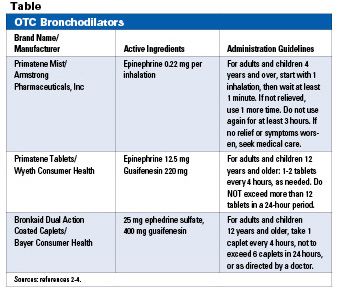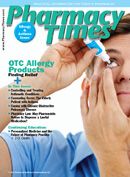Publication
Article
Pharmacy Times
OTC Products for Bronchial Asthma: What Patients Need to Know
Author(s):
Self-treatment of asthma is not always appropriate, but pharmacists can help patients with asthma determine if OTC treatment is right for them.
Self-treatment of asthma is not always appropriate, but pharmacists can help patients with asthma determine if OTC treatment is right for them.
There are only a few OTC products available for the management of mild and infrequent symptoms associated with bronchial asthma. The Table shows OTC asthma medications that are available for inhalation or oral use. Inhaled medications that contain the bronchodilator epinephrine and oral medications contain a combination of the bronchodilator ephedrine and the expectorant guaifenesin. These products are FDA approved for the temporary relief of shortness of breath, tightness in the chest, and wheezing due to asthma.1 They should be used for mild and infrequent symptoms or exacerbations lasting less than 2 days and only after a diagnosis of asthma has been established.1 Patients with concurrent medical conditions, those with persistent and severe asthma symptoms, and those with no prior diagnosis of asthma should always be referred for further medical evaluation and should not use these products unless directed by a physician.1

On November 19, 2008, the FDA ruled that the sale of chlorofluorocarbon (CFC)-containing epinephrine metered dose inhalers be phased out by December 31, 2011, after which inhalers containing CFCs cannot be manufactured or sold in the United States.1,2 The decision to eliminate epinephrine metered dose inhalers complies with the national and international laws aimed at decreasing ozone depletion caused by CFCs.3 The manufacturer of the epinephrine inhaler Primatene Mist (Armstrong Pharmaceuticals, Inc) will comply with the final FDA ruling to have a CFC-free product available before the ruling expiration date.1,3Health care professionals should make patients who use metered dose inhalers aware of these upcoming changes. On September 25, 2009, the FDA hosted a 1-day public workshop to discuss the phase-out of nonprescription CFC epinephrine metereddose inhalers from the US market.4 The purpose of the workshop was to obtain feedback from important partners in the asthma community—such as experts in the health care profession, health care communications, and the pharmaceutical industry—on how best to inform patients about the changes and assist them in finding therapeutic alternatives.4
Patients for whom self-treatment of bronchial asthma may be appropriate include those who have a prior diagnosis of intermittent asthma from a physician, those whose symptoms are mild and have a short duration (eg, <24 hours), patients who are aware of the warning signs of asthma that require urgent medical care, and patients who do not have any other serious medical conditions that may worsen breathing, such as chronic obstructive pulmonary disease or coronary artery disease.1
Prior to recommending any of these OTC asthma products, pharmacists should screen for potential drug interactions and contraindications. Due to the risks of cardiovascular-related adverse effects, older patient populations should be advised not to use these products and seek medical advice from their primary health care provider about treatment options. In addition, those patients who are concurrently taking monoamine oxidase inhibitors, those taking prescription asthma medications, and those with cardiovascular disease, hypertension, thyroid disease, diabetes, or enlarged prostate should not use these products.1,5-7 Pregnant and lactating women and children should not utilize these products without consulting their primary health care provider.
During counseling, patients electing to use these products should be instructed to seek medical care immediately if they experience frequent and severe asthma symptoms, especially if they have not been previously diagnosed with asthma. It is also important for pharmacists to alert patients who use OTC inhalers of the current FDA regulations, and encourage these patients to discuss the various prescription medication alternatives with their primary health care provider to manage and control their asthma symptoms. Patients should be thoroughly educated on the proper use of an inhaler device and be reminded to clean the mouthpiece after each use with hot, soapy water, rinse thoroughly, and dry with a clean, lint-free cloth. Patients should also be advised to seek medical care if symptoms worsen, are not relieved within 20 minutes of using the inhaler, or if they use more than 9 inhalations a day for more than 3 days a week and have more than 2 asthma attacks in a week.5 The adverse effects associated with the use of inhaled medications include nervousness and tachycardia.1,5
Patients taking oral bronchodilators should be reminded to adhere to the recommended dosage guidelines and warnings listed on the product label, and seek medical care immediately if symptoms do not improve or worsen within 20 minutes of using these products, or if they use more than 8 tablets a day for more than 3 days a week and have more than 2 asthma attacks in a week.1,6,7 The tablets are not intended for use in children younger than 12 years of age.1,6,7 The adverse effects associated with the use of ephedrine include palpitations, tachycardia, nervousness, nausea, loss of appetite, and insomnia. Patients should also be advised to discontinue the use of oral asthma medications if they experience any adverse reactions and immediately contact their primary health care provider.
During counseling, patients should be reminded that those with asthma should be routinely monitored by a primary health care provider, be aware of potential asthma triggers, and be advised that concomitant conditions, such as gastroesophageal reflux disease, allergic rhinitis, and smoking, can actually worsen asthma symptoms.1 â–
For more information on the FDA regulation of OTC metered dose inhalers, please visit the following FDA Web sites:
• Epinephrine CFC Metered-dose Inhalers-Questions and Answers
www.fda.gov/Drugs/DrugSafety/InformationbyDrugClass/ucm080427.htm#1
• Letter Regarding Phase-out of Epinephrine CFC MDIs
www.fda.gov/Drugs/resourcesforyou/ucm080628.htm
• Educating the Public About Removal of Essential-Use Designation for Epinephrine
www.fda.gov/Drugs/NewsEvents/ucm180277.htm
Ms. Terrie is a clinical pharmacy writer based in Haymarket, Virginia.
References
1.
Bollmeier S and Prosser T. Asthma. In: Berardi R, Newton G, McDermott JH, et al, eds. Handbook of Nonprescription Drugs 16th Ed. Washington, DC: American Pharmacists Association; 2009:213-228.
2.
Educating the Public about Removal of Essential-Use Designation for Epinephrine. The Food and Drug Administration website. www.fda.gov/Drugs/NewsEvents/ucm180277.htm. Accessed January 27, 2010
3.
Traynor K. FDA Looks Ahead to Withdrawal of Nonprescription Epinephrine Inhalers. American Society of Health Systems Pharmacists website
.
www.ashp.org/import/news/HealthSystemPharmacyNews/newsarticle.aspx?id=3191. Accessed January 27, 2010
4.
FDA seeks input on epinephrine MDI phase-out. American Academy of Allergy Asthma and Immunology website. . www.aaaai.org/members/newsandupdates.asp?search=FDA. Accessed January 27,2010
5.
Primatene Mist Products Information. Armstrong Pharmaceuticals, Inc. website.www.primatene.com/index.asp. Accessed January 25, 2010.
6.
Primatene Tablets Product Information. Wyeth Consumer Healthcare website. www.primatenetablets.com/products/primatene_tablets.asp. Accessed January 25, 2010.
7.
Bronkaid Tablets Product Information. Bayer Consumer Care Products website. www.bayercare.com/Bronkaid_faq.cfm. Accessed January 25, 2010.







